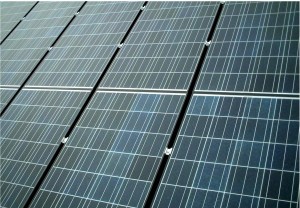Renewable Energy Substantially Cuts Water Use

Power generation accounts for 39% of water usage in the US. Coal, natural gas, and nuclear power plants use the most amount of water while renewable energy like wind and solar photovoltaic use the least. Increasing competition for water coupled with current droughts make it all the more important to devise new ways to create electricity without using nearly as much water.
Opflow, a journal of the American Water Works Association discusses this and more in a thoughtful publication “How Can We Avoid the Coming Power Struggle for Water?” (PDF) Agriculture uses 40% of water followed closely by thermoelectric energy production at 39%. Thermoelectric is power generated from a heat source like coal, natural gas, nuclear, biomass, or concentrated solar. It requires water for cooling or to power steam turbines.
In the American West, a major use of electricity is for pumping water hundreds of miles to its destination. (Of course water is pumped in other parts of the country but just not as far.) Thus we have the improbable result of water being used to create power to pump water, something which clearly is not sustainable in the long term.
Some highly touted forms of renewable fuels like biofuels are, to put it charitably, water pigs. Worse, such biofuels are often produced in areas with limited water, even as they use prodigious amounts of water. Ethanol production requires 1,000 gallons of water to create 1 gallon of fuel. Soy biofuel is even worse, at a staggering 6,000 to 1 gallon of fuel. Clearly, it seems nearly insane to use so much water to create these types of biofuels.
Water treatment plants use substantial amounts of electricity but the waste biosolids they create can easily be converted to methane to power mini-turbines or fuel cells, thus generating more power for the treatment plant. This is just one of the solutions suggested by Opflow as ways to generate electricity without using so much water. Methane from landfills can also generate power. More efficient water pumps and HVAV units will also help. However, their primary recommendation is to install solar photovoltaic on roofs everywhere as well as building more wind farms. Solar PV and wind power use tiny amounts of water and thus lessen competition for water and make it more available for other uses.
Why use water to create power if we don’t have to?



